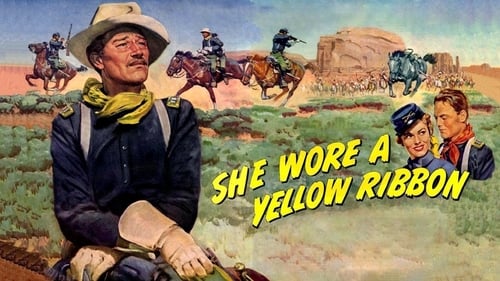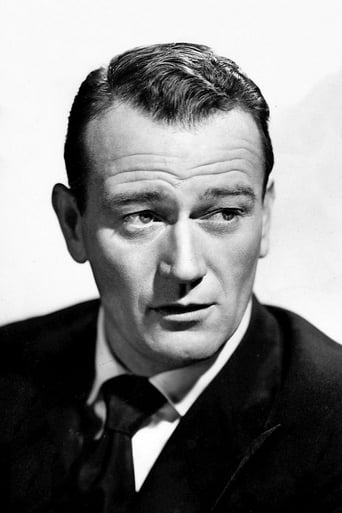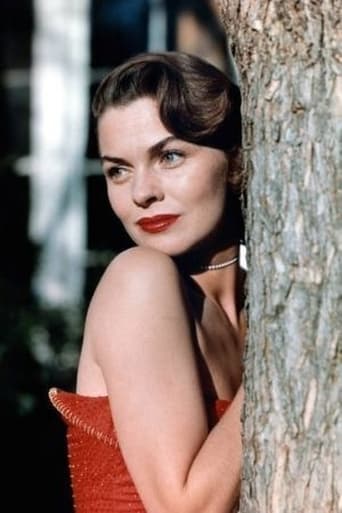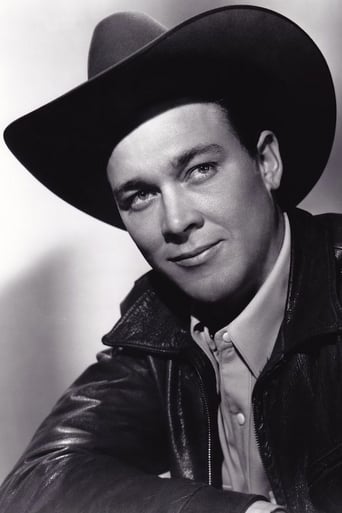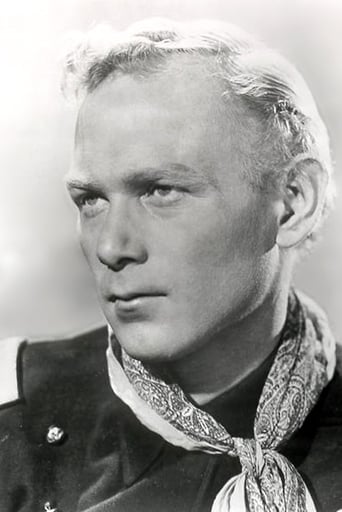Wuchak
Released in 1949 and directed by John Ford, "She Wore a Yellow Ribbon" stars John Wayne as a captain near retirement who takes out a final patrol to alleviate an impending Native attack after tribes unite, emboldened by Custer's humbling defeat at Little Big Horn. Unfortunately, his duty is hindered by two women who must be evacuated from the fort, the younger one attracting the attentions of two junior officers (John Agar & Harry Carey Jr.). Ben Johnson has a significant role as a dependable sergeant. How do you review an old Western like this when you can't stand old-fashioned scores and hokey antiquated songs, not to mention the incongruent campy elements and slapstick (non)humor Ford is known for? Basically you have to ignore these factors and focus on the story and the actors. If you can do this, "She Wore a Yellow Ribbon" is worth checking out. Wayne was lean & mean at almost 42 (during shooting), but made out to be twenty years older for the role, while Dru was a striking hottie at almost 26. It's also cool seeing Johnson and Carey Jr. when they were so young. And the bright color photography really brings the film alive, particularly the gorgeous Monument Valley locations, unlike the flat B&W presentations of "Fort Apache" (1948) and "Rio Grande" (1950), the other two in Ford's cavalry trilogy. Amazingly, the film utilizes real Native Americans for the cast and the movie gets extra points for this and their respected, accurate portrayal. The film runs 103 minutes and was shot in Utah; Kayenta, Arizona; and California (studio). The screenplay was written by Frank S. Nugent & Laurence Stallings from a story by James Warner Bellah.GRADE: B-
jacobs-greenwood
The best of director John Ford's (and actor John Wayne's) U.S. Cavalry trilogy, which includes Fort Apache (1948) and Rio Grande (1950), this essential Western won Cinematographer Winton Hoch his second of three Oscars (on three nominations). Hoch's sweeping views of Utah's Monument Valley and beautiful blue, cloud dotted skies are unforgettable. It's based on stories by James Warner Bellah that were adapted by Frank Nugent and Laurence Stallings. Ford and Merian C. Cooper were its executive producers.Wayne stars as a retiring officer, Nathan Cutting Brittles, trying to stave off a pending Indian attack, after General Custer's massacre. John Agar, Ben Johnson as Sergeant Tyree, Harry Carey Jr., and Victor McLaglen (the drinking Irishman) as Sergeant Quincannon are under his command; Joanna Dru is among the women whose evacuation complicates his plans.Of course, affections for the lovely Ms. Dru's character, among the two young lieutenants (Agar and Carey Jr.), is an additional source of conflict. Wayne, for whom Dru wears the yellow ribbon, must lead and help these two grow to fill his job, in the less than a week he's got left until retirement.
weezeralfalfa
John Ford finally relented in his preference for B&W film making to give us a long overdue look at the predominantly rusty-colored spectacular Monument Valley backdrops featured in major portions that took place outside of the fort. The sequences when the cavalry is walking their horses, with a thunderstorm or mist in the background, are particularly memorable as a mood setter.Duke Wayne is back from the previous year's "Fort Apache", again as second in command, technically. But this time, he pretty much runs the show, with minimal interference from easy-going fort-bound Major MacAllshard, who is very different from Fonda's up-tight dictatorial Colonel Thursday in "Fort Apache". Here, Wayne plays a much older man, around 60, who is due to retire in a few days. Very much the father figure for the younger set. John Agar also returns from "Fort Apache" to play a similar role as the young lieutenant romantic lead. But instead of actual wife Shirley Temple, he has equally luscious-looking Joanne Dru to woo. And, he has stiff competition this time from Harry Carey Jr.. The volatile relationship between these 3 very much brings back memories of a similar sparring between cavalrymen Errol Flynn and Ronny Reagan over Olivia de Havilland, in "Santa Fe Trail". Dru's character is even named Olivia. Actually, Olivia seems much more in love with Wayne's mature character than with the sparring young duo. Obviously, Ford was impressed with the acting of Duke and feisty Dru in the previous year's outstanding western "Red River". Wayne is back with his older, more authoritarian, persona exhibited in that film, plus a moustache. But, again, the mood of the film is quite different: much more relaxed.Ben Johnson, another relatively young buck, is given his most visible film role to that point, as Wayne's chief scout. Likable Ben was a real Oklahoma cowboy and champion horse rider, and would team with Harry Carey Jr. as the laconic male stars in Ford's "The Wagon Masters", the following year. Dru would also return as the female star in that film. Ben rode two famous horses in this and the latter films: Steel and Bingo. Steel was valued as making riders look especially good, while Bingo was a champion galloper.The abundant music, while repetitive, consists mostly of well-known spirited traditional songs, mostly about sweethearts, often sung by troops through the years, including my Vietnam-era training troop. It certainly adds to the generally relaxed, jovial, tone of the film.Charismatic Victor McLaglen is back from "Ft. Apache", serving as the thoroughly Irish, whiskey-fired, top sergeant cut up. He is the star of an extended slapstick brawl. Ford often had at least one fisted brawl in his westerns, which might be serious, slapstick, or a mix of the two. He always included some humor in his films, however subtle, and there is plenty in this one. One type of humor is running gags or lines. Duke's repetitive "Never apologize, it's a sign of weakness" is an example. The film opens with an attack by Cheyenne Dog Soldiers(a military-oriented brotherhood) on the fort paymaster stage, to obtain money to buy more rifles. 20 years later, the much Vietnam War-influenced cavalry western "Soldier Blue" would open with a similar Cheyenne attack, again to obtain money to buy rifles. Unlike "Ft. Apache" and the subsequent "Rio Grande", a battle with Apaches is not included in this film. Besides Cheyenne, Arapahoes, Kiowas, and Comanches are mentioned as putting aside their traditional animosities, forming a common military alliance against rapidly encroaching Europeans. As in "Ft. Apache", Wayne makes a daring parley visit to the hostile 'Indian' encampment. There are no battles between mounted 'Indians' and cavalry. In several instances, the cavalry merely sees the results of an 'Indian' attack, including the satisfying murder of the gun-running fort sutlers. However, there is the late dramatic stampeding of the 'Indian' warrior's horses through their camp in the dead of night, as Wayne's commission as a soldier expires. The point was to limit the ability of the warriors to fight, with minimal bloodshed on either side. This episode encapsulates the result of the historic Red River War, headed by Colonel MacKenzie, which effectively ended the Indian Wars on the southern plains. Another MacKenzie-lead exploit is the basis of the subsequent "Rio Grande".... Wayne thinks his military career is now over, and we see him riding off into the sunset. But, he's in for a surprise!Irishman Ford actually identified with Native Americans as another group, who like the Irish, were commonly persecuted by mainstream Anglo-Saxon society. Thus, he usually tried to portray them in a relatively favorable light, although he knew that most of his audiences expected them to be mostly cast as expendable impediments to western expansion. This favoritism is seen most vividly in his last cavalry western: "Cheyenne Autumn", especially in the bizarre "Dodge City" segment.
wes-connors
In 1876, following Custer's last stand, Cavalry Captain John Wayne (as Nathan Brittles) is about to retire. But, first, Mr. Wayne must fend off encroaching Native Americans. The "hostile Indians" may be after white women and/or white man's land. Wayne's last assignment is to accompany pretty Joanne Dru (as Olivia Dandridge) and her aunt Mildred Natwick (as Abby Allshard) to a stagecoach east. Along for the trek, younger Lieutenants John Agar (as Flint Cohill) and Harry Carey Jr. (as Ross Pennell) are enamored with the nubile Ms. Dru, who signals she's "interested" by wearing yellow ribbon in her hair.Photographer Winton Hoch won an "Academy Award" for his beautiful cinematography, in this typically well-directed John Ford opus. Ford favorites Ben Johnson (as Tyree), Victor McLaglen (as Quincannon), and George O'Brien (as Allshard) are along for the ride. Wayne is outstanding and probably should have been nominated for a "Best Actor" award for his "She Wore a Yellow Ribbon" role - instead, Oscar nominated him for "Sands of Iwo Jima" (also 1949). Both films helped propel Wayne to #1 on the (industry standard) "Quigley" list of "Box Office Stars" for 1950. He stayed in the "Top Ten" list for most years thereafter.******** She Wore a Yellow Ribbon (10/22/49) John Ford ~ John Wayne, Joanne Dru, John Agar, Harry Carey Jr.


